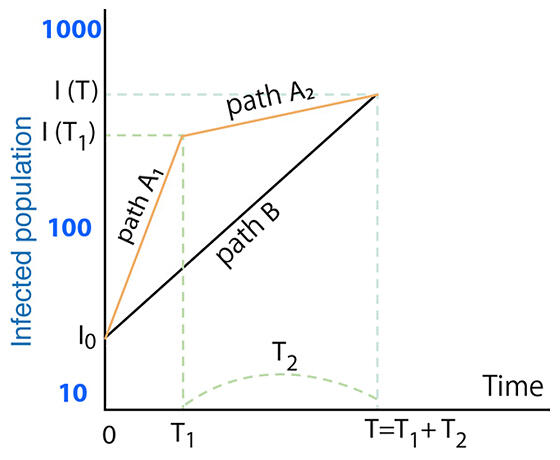Associate Professor Tsuyoshi Hondou of the Graduate School of Science at Tohoku University published his research showing the basic principles required for making infectious disease control compatible with economic activities. For the analysis, he used a methodology from theoretical physics with cost‐benefit analysis and one from theoretical epidemiology to demonstrate that if countermeasures of appropriate intensity are taken continuously and systematically from the early stage of infection, it is possible to balance life support and economy while limiting damage in both.
This result ultimately stood in contrast to 'the basic action policy,' which the government has been advancing to deal with COVID‐19 up to the present day. This result is expected to be included in future countermeasures for infectious diseases and was published in the Journal of the Physical Society of Japan, an international academic journal.

©Tsuyoshi Hondou
In terms of countermeasures for an infectious disease, a lockdown or other countermeasures can be used to suppress the number of infected persons and deaths; however, a reduced economy and/or financial stringency may result if such countermeasures continue. Given the possibility of other problems arising because of poverty or related factors, it is necessary to take infectious disease countermeasures compatible with the economy.
According to its basic action plan, the government of Japan will not undertake any proactive countermeasure, such as declaring a state of emergency, until the economic effect of an infectious disease reaches a worrying level. As a result, the number of new deaths due to the novel coronavirus infection has increased annually since 2020, when the first infected person in Japan was examined medically. In January of this year, Japan suffered the most COVID deaths of any month, the highest death rate in the G7.
In this research, Hondou analyzed the appropriate intensity and timing of countermeasures to minimize economic loss and the loss of life under the conditions that kept the number of infected persons at the peak of infection below a certain level for the purpose of preventing a healthcare collapse or similar event. He used general theories in theoretical physics, cost‐benefit analysis and theoretical epidemiology in the analysis, which can be applied to other infections with high predictability.
He established the following general assumptions: (1) the number of infected persons increases or decreases exponentially according to the effective reproduction number (the average number of persons that one infected person infects throughout his or her infection at a certain point of time); (2) the countermeasures for infection are adopted according to the degree of excellence in the cost effectiveness (based on the intensity of each countermeasure and the effective reproduction number); and (3) the social cost is equal to the economic influence cost combined with the medical cost. Furthermore, he considered the seasonality of the infectious diseases that spread through the air such as COVID‐19 (the spread of infection within a limited period).
Accordingly, as he compared the cost of continuing appropriate countermeasures from an early stage and that of a strict countermeasure immediately before a crisis, he concluded that the former always resulted in minimal economic loss and loss of life.
Hondou said, "This theory cannot be applied to situations where the number of infected persons starts to decrease because of temporary herd immunity due to the infection spreading widely. In the future, I want to find a theory with further generality that can be applied to a wide variety of conditions."
Journal Information
Publication: Journal of the Physical Society of Japan
Title: Timely Pandemic Countermeasures Reduce both Health Damage and Economic Loss: Generality of the Exact Solution
DOI: 10.7566/JPSJ.92.043801
This article has been translated by JST with permission from The Science News Ltd. (https://sci-news.co.jp/). Unauthorized reproduction of the article and photographs is prohibited.




